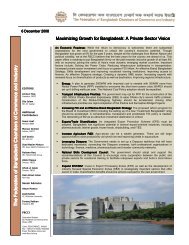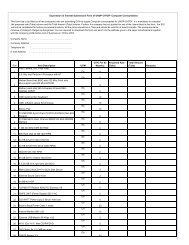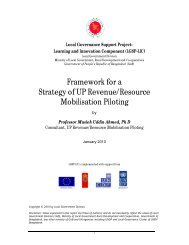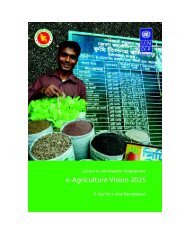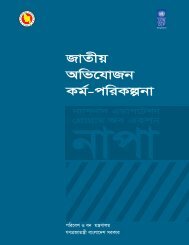The probable impacts of climate change on poverty - UNDP
The probable impacts of climate change on poverty - UNDP
The probable impacts of climate change on poverty - UNDP
You also want an ePaper? Increase the reach of your titles
YUMPU automatically turns print PDFs into web optimized ePapers that Google loves.
Major Changes and Impacts<br />
Crop loss/yield<br />
reducti<strong>on</strong> (%)<br />
Wheat is affected by drought and shorter winter period 20<br />
Rabicrops/vegetables, pulses being affected due to moisture stress<br />
and fogginess<br />
30<br />
Fruit dropping due to moisture stress, B deficiency and fogginess 30<br />
Increasing incidence <str<strong>on</strong>g>of</str<strong>on</strong>g> pests and diseases<br />
Source: Key experts interviews and workshop for MDG-GED project, 2008<br />
Table 6.5 Percepti<strong>on</strong> <str<strong>on</strong>g>of</str<strong>on</strong>g> Present Level <str<strong>on</strong>g>of</str<strong>on</strong>g> Impacts related to Climate Change <strong>on</strong> Crop Agriculture in<br />
the Coast Areas<br />
44<br />
Major Changes and Impacts<br />
<str<strong>on</strong>g>The</str<strong>on</strong>g> Probable Impacts <str<strong>on</strong>g>of</str<strong>on</strong>g> Climate Change <strong>on</strong> Poverty and Ec<strong>on</strong>omic Growth and<br />
the Opti<strong>on</strong>s <str<strong>on</strong>g>of</str<strong>on</strong>g> Coping with adverse Effect <str<strong>on</strong>g>of</str<strong>on</strong>g> Climate Change in Bangladesh<br />
15<br />
Crop loss/yield<br />
reducti<strong>on</strong> (%)<br />
Increasing soil salinity with extent and severity 20<br />
Swelling/heavy clays/salt crusting in land preparati<strong>on</strong> 15<br />
Degradati<strong>on</strong> <str<strong>on</strong>g>of</str<strong>on</strong>g> soil physical/chemical properties due to prol<strong>on</strong>ged<br />
25<br />
water stagnancy creating micro-nutrient deficiencies <str<strong>on</strong>g>of</str<strong>on</strong>g> S and Zn<br />
wetland rice cultivati<strong>on</strong>.<br />
Increasing soil-related c<strong>on</strong>straints (viz.swelling/cracking clays, soil<br />
30<br />
wetness) that create problems in land preparati<strong>on</strong><br />
Late planting <str<strong>on</strong>g>of</str<strong>on</strong>g> rabi crops due to delaying in recessi<strong>on</strong> <str<strong>on</strong>g>of</str<strong>on</strong>g> flood water<br />
20<br />
and soil wetness<br />
Damage <str<strong>on</strong>g>of</str<strong>on</strong>g> standing crops (khesari, soybean, groundnut) due to<br />
30<br />
moisture stress and salinity<br />
Increasing water-logged areas keeping more cultivable land as fallow in<br />
Fallow: 50%<br />
Rabi, Kharif-I and Kharif-II seas<strong>on</strong><br />
Changes in crops/cropping pattern with varieties 10 (increase)<br />
Rainfed aus crop is affected by drought and salinity<br />
Boro and wheat is affected by salinity<br />
C<strong>on</strong>versi<strong>on</strong> <str<strong>on</strong>g>of</str<strong>on</strong>g> crop land into shrimp culture<br />
Increasing incidences <str<strong>on</strong>g>of</str<strong>on</strong>g> pests and diseases<br />
Decreasing income source <str<strong>on</strong>g>of</str<strong>on</strong>g> the poor in coastal areas<br />
Source: Key experts interviews and workshop for MDG-GED project, 2008<br />
Experts have also expressed their views <strong>on</strong> changing cropping pattern. Changes in characteristics such as<br />
untimely and prol<strong>on</strong>ged flooding, erratic rainfall, temperature variati<strong>on</strong>, prol<strong>on</strong>ged drought, <str<strong>on</strong>g>change</str<strong>on</strong>g>s in the<br />
length <str<strong>on</strong>g>of</str<strong>on</strong>g> winter and summer seas<strong>on</strong>s have identified as <str<strong>on</strong>g>climate</str<strong>on</strong>g> <str<strong>on</strong>g>change</str<strong>on</strong>g> related drivers. Key experts informed<br />
that the length <str<strong>on</strong>g>of</str<strong>on</strong>g> winter seas<strong>on</strong> is decreasing whereas summer is increasing. Present cropping seas<strong>on</strong>s are also<br />
facing uneven distributi<strong>on</strong> <str<strong>on</strong>g>of</str<strong>on</strong>g> rainfall and temperature variati<strong>on</strong> which is leading seas<strong>on</strong>al adjustment in the<br />
cropping pattern and in most cases these are temporary <str<strong>on</strong>g>change</str<strong>on</strong>g>s. Moreover, crop land is transferring to<br />
horticulture especially in the drought pr<strong>on</strong>e area. This reduces rice crop producti<strong>on</strong> c<strong>on</strong>siderably at local level<br />
but significant implicati<strong>on</strong> is limiting rural livelihood opportunities in crop agriculture.<br />
Damage <str<strong>on</strong>g>of</str<strong>on</strong>g> crop is another key effect <str<strong>on</strong>g>of</str<strong>on</strong>g> <str<strong>on</strong>g>climate</str<strong>on</strong>g> variability and extremes. Flood (all types) and cycl<strong>on</strong>e damage<br />
standing crops severely. Department <str<strong>on</strong>g>of</str<strong>on</strong>g> Agriculture Extensi<strong>on</strong> (DAE) under the Ministry <str<strong>on</strong>g>of</str<strong>on</strong>g> Agriculture has<br />
30<br />
20<br />
30<br />
20




